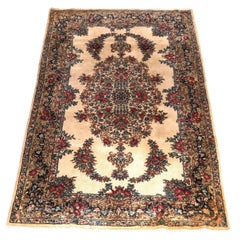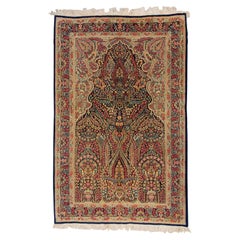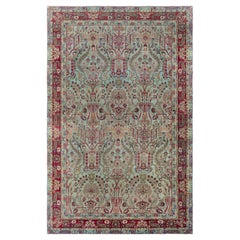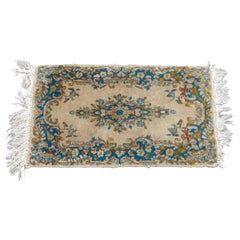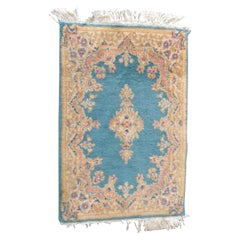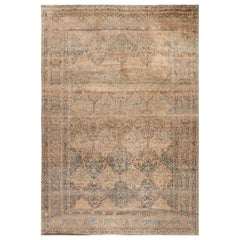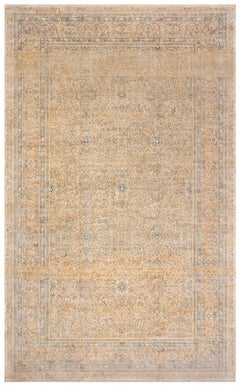Kirman Oriental Rugs
Early 20th Century Persian Rugs
Wool
Mid-20th Century Central Asian Other Central Asian Rugs
Wool
Early 20th Century Persian Kirman Persian Rugs
Wool
20th Century Chinese Persian Rugs
Wool
20th Century Persian Persian Rugs
Wool, Cotton
Antique Late 19th Century Persian Kirman Persian Rugs
Wool
Early 20th Century Persian Kirman Persian Rugs
Wool
Antique Late 19th Century Persian Kirman Persian Rugs
Wool
Early 20th Century Persian Kirman Persian Rugs
Wool
Antique Late 19th Century Persian Kirman Persian Rugs
Wool
Antique Late 19th Century Persian Tabriz Persian Rugs
Wool
1990s Azerbaijani Kirman Central Asian Rugs
Organic Material, Wool, Cotton
1990s Afghan Kirman Central Asian Rugs
Organic Material, Cotton, Wool
20th Century Turkish Kirman Turkish Rugs
Wool
Vintage 1910s Persian Kirman Persian Rugs
Wool
Vintage 1930s Persian Kirman Turkish Rugs
Wool
Antique Late 19th Century Persian Kirman Persian Rugs
Wool
Antique Late 19th Century Persian Kirman Persian Rugs
Wool
Antique Mid-19th Century Persian Kirman Persian Rugs
Wool
Antique Late 19th Century Persian Kirman Persian Rugs
Wool
1990s Asian Kirman Persian Rugs
Wool
Early 20th Century Persian Kirman Persian Rugs
Wool
Antique Late 19th Century Persian Kirman Persian Rugs
Wool
Early 20th Century Persian Kirman Persian Rugs
Wool
Antique Late 19th Century Persian Kirman Persian Rugs
Wool
Mid-20th Century Persian Kirman Persian Rugs
Wool
Early 20th Century Persian Kirman Persian Rugs
Wool
Vintage 1920s Persian Kirman Persian Rugs
Antique 1890s Persian Kirman Persian Rugs
Wool
Mid-20th Century Persian Persian Rugs
Wool
Early 20th Century Asian Persian Rugs
Wool
20th Century Persian Persian Rugs
Wool
20th Century American North and South American Rugs
Wool, Cotton
Mid-20th Century Persian Persian Rugs
Wool, Cotton
Mid-20th Century Kirman Persian Rugs
Wool
Mid-20th Century American Moorish More Carpets
Wool
Mid-20th Century American Kirman Persian Rugs
Wool
Mid-20th Century Kirman Persian Rugs
Wool
Late 20th Century Kirman Persian Rugs
Wool
20th Century Persian Persian Rugs
Wool
Early 20th Century Asian Kirman Persian Rugs
Wool
20th Century Persian Persian Rugs
Wool
20th Century Iraqi Persian Rugs
Wool
Early 20th Century Persian Persian Rugs
Wool
Mid-20th Century Persian Persian Rugs
Wool
Mid-20th Century American North and South American Rugs
Wool
20th Century American Persian Rugs
Wool
20th Century American More Carpets
Wool
20th Century American More Carpets
Wool
Mid-20th Century Persian Persian Rugs
Wool
Early 20th Century Persian Persian Rugs
Wool
Early 20th Century Persian Persian Rugs
20th Century Central Asian Rugs
Wool
Early 20th Century Persian Persian Rugs
Wool
Mid-20th Century Persian Kirman Persian Rugs
Wool
20th Century Persian Persian Rugs
Wool
2010s Afghan Kirman More Carpets
Wool
2010s Persian Kirman More Carpets
Wool
2010s Afghan Kirman More Carpets
Wool
Vintage 1910s Persian Kirman Turkish Rugs
Wool
- 1
Kirman Oriental Rugs For Sale on 1stDibs
How Much are Kirman Oriental Rugs?
A Close Look at Kirman Furniture
Antique and vintage Kirman rugs and carpets are named for the southern Iranian city that has been a renowned major center of high-quality carpet production since the 16th century. These furnishings are considered works of art and are celebrated for their fine craftsmanship, sumptuous colors and durability.
This type of Persian carpet is sometimes spelled Kerman, like its place of origin, the capital of the Western Asian country’s Kerman Province. Iran encompasses different cultures, languages and dialects, and its exquisite rugs reflect this diversity.
The different types of Persian carpets are named for the towns, villages and regions where they’re made. Kirman rugs, carpets, wall hangings and other textiles have long been popular with international audiences, including in the early 20th century when they were marketed as Kermanshah carpets. Compared to other Persian rugs, Kirman examples are known for being vividly colored with natural dyes and characterized by a diverse variety of patterns, ranging from arabesques embedded with floral touches and details like deer and lions to overlapping cartouches in a broad palette of rich hues.
Others feature an ornate central medallion, vase shapes, rows of shrubs or a flourishing tree of life created through an asymmetrical knotting technique so that the wool pile on cotton is “double warped.” Some of the more elaborate carpets commissioned from the Kirman workshops in the 18th and 19th centuries included large-scale naturalistic scenes based on European paintings or Gobelin tapestries.
The major workshops of Kerman informed weaving in nearby rural areas such as those created by the Afshar tribe. The international popularity of Kirman carpets, meanwhile, inspired designers across the globe, such as William Morris in England. A leading designer of the Arts and Crafts movement, Morris revived historical techniques such as printed fabrics in the furnishings he created. He owned Kirman carpets and used them as a source for his work.
Both vintage and contemporary rugs influenced by Kirman designs remain in demand for their lavish palette and distinctive patterns. In 2013, a 17th-century Kirman carpet was sold at a Sotheby’s auction for an astounding $33.8 million.
Find a range of antique Kirman rugs and carpets, wall decorations and other furniture on 1stDibs.
Finding the Right Rugs-carpets for You
Good antique rugs and vintage rugs have made their way into homes across the globe, becoming fixtures used for comfort, prayer and self-expression, so choosing the right area rug is officially a universal endeavor.
In modern usage, “carpet” typically denotes a wall-to-wall floor cushioning that is fixed to the floor. Rugs, on the other hand, are designed to cover a specific area and can easily be moved to new locations. However, the terms are interchangeable in many parts of the world, and, in the end, it won’t matter what you decide to call it.
It’s well known that a timeless Persian rug or vintage Turkish rug can warm any interior, but there are lots of other styles of antique rugs to choose from when you're endeavoring to introduce fresh colors and textures to a bedroom or living room.
Moroccan Berber rugs are not all about pattern. In fact, some of the most striking examples are nearly monochrome. But what these rugs lack in complexity, they make up for in brilliant color and subtle variation. Moroccan-style interiors can be mesmerizing — a sitting room of this type might feature a Moroccan rug, carved wooden screens and a tapestry hung behind the sofa.
Handwoven kilim rugs, known for their wealth of rich colors and unique weaving tradition, are pileless: Whereas the Beni Ourain rugs of Morocco can be described as dense with a thick surface or pile, an authentic kilim rug is thin and flat. (The term “kilim” is Turkish in origin, but this type of textile artistry is practiced all across the Balkans, throughout the Arab world and elsewhere.)
When it comes to eye-catching floor coverings, the distinctive “medallion” pattern of Oushak rugs has two types of rounded shapes alternating against a rich red or blue background created with natural dyes, while the elaborate “star” pattern involves large eight-pointed shapes in diagonal rows alternating with diamonds.
If you’re looking for something unexpected, find a runner rug that pops in your hallway or on your stairs. Dig for dazzling geometric patterns in our inventory of mid-century modern rugs and carpets, which includes works designed by the likes of Swedish textile masters Märta Måås-Fjetterström, Marianne Richter and other artisans.
Carpets and rugs have been around for thousands of years. Prehistoric humans turned to animal skin, wool and fur to craft simple fabrics to soften hard terrain. A 2016 study suggests that "cave lions" were hunted for exactly this purpose, and that decorating your cave with their pelts may have conferred strength and prestige. Although many of these early textiles are still in existence, tracing their precise origins is difficult. Carpets quickly became such a valuable trade commodity that the weavings could easily travel far from their places of origin.
The oldest known carpet was found in southern Siberia. (It may have traveled there from Persepolis in Iran.) For the flat-weave floor rugs crafted by Native Americans, cotton was the primary material before sheep’s wool was introduced in the 16th century. In Europe, carpet-making was fundamental to folk art, and Asian carpets imported to European countries were at one time considered a precious luxury and not intended to remain permanently on the floor.
With the variety of area rugs and carpets rolled out for you on 1stDibs — a collection that includes traditional, modern, minimalist rugs and other coverings of all kinds — things will be looking up whenever you’re looking down.
- 1stDibs ExpertSeptember 28, 2021Both Oriental and Persian rugs are hand knotted on looms. While Oriental rugs are tied with symmetrical Ghiordes knots, Persian rugs are tied using an asymmetrical or Senneh knot. Find a collection of vintage and antique Oriental and Persian rugs on 1stDibs.
 NazmiyalMarch 23, 2021If you fold the rug and follow the pile down to the foundation and see that it has a knot at the end of it then it was made by hand. No machine can make the physical knot which is why they need apply glue or some sort of adhesive on the back to keep the pile from getting pulled out.
NazmiyalMarch 23, 2021If you fold the rug and follow the pile down to the foundation and see that it has a knot at the end of it then it was made by hand. No machine can make the physical knot which is why they need apply glue or some sort of adhesive on the back to keep the pile from getting pulled out.
